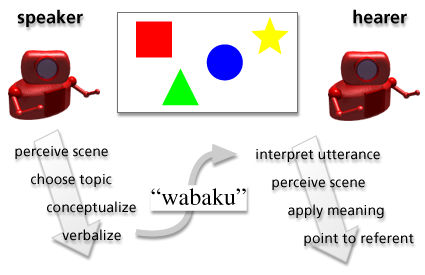The Guessing Game
The guessing game is a language game played by two players. One person or artificial agent plays the role of speaker and the other one then plays the role of hearer. Players look at a scene which consists of a white board on which various objects are attached. The speaker chooses one object from the scene, further called the topic, and gives a verbal hint to the hearer so that he or she can guess what topic the speaker had in mind.

The verbal hint is a word or set of words that identifies the chosen topic with respect to the objects in the background. For example, if the context contains [1] a red square, [2] a blue triangle, and [3] a green circle, then the speaker may say something like "the red one" to communicate that [1] is the topic. If the context contains also a red triangle, he has to be more precise and say something like "the red square". The artificial agents start with no prior human-supplied set of categories nor lexicon. A shared ontology and lexicon must emerge from scratch in a self-organised process. The agents therefore do not say "the red square" but use their own language and concepts which are never going to be the same as those used in English. For example, they may say "malewina" to mean [UPPER EXTREME-LEFT LOW-REDNESS]. Human players have to try and guess the language of the Talking Heads to have success in communicating with them, even though they may attempt to teach the artificial agents words from human languages.
Based on the verbal hint, the hearer tries to guess what topic the speaker has chosen, and communicates his choice to the speaker by pointing to the object.
The game succeeds if the topic guessed by the hearer is equal to the topic chosen by the speaker. In this case both the speaker and the hearer get points. The game fails if the guess was wrong or if the speaker or the hearer failed at some earlier point in the game. In this case nobody gets any point, but the speaker gives a non-verbal hint by pointing to the topic, and both players have an opportunity to form new hypotheses about the words and meanings of the other. In this way, they can build up their vocabularies.





![[Experiments]](../../inline/bannerExperiments.jpg)